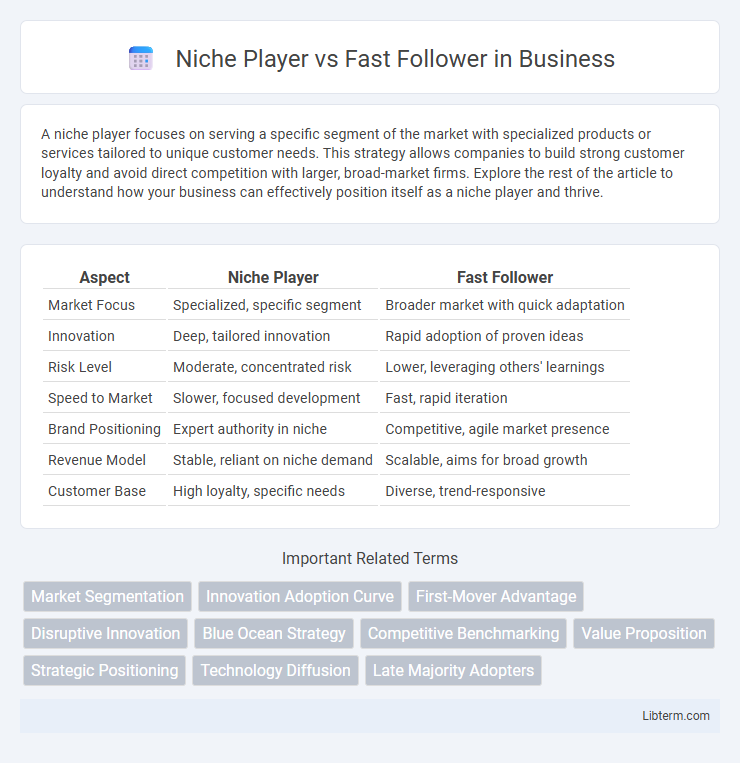A niche player focuses on serving a specific segment of the market with specialized products or services tailored to unique customer needs. This strategy allows companies to build strong customer loyalty and avoid direct competition with larger, broad-market firms. Explore the rest of the article to understand how your business can effectively position itself as a niche player and thrive.
Table of Comparison
| Aspect | Niche Player | Fast Follower |
|---|---|---|
| Market Focus | Specialized, specific segment | Broader market with quick adaptation |
| Innovation | Deep, tailored innovation | Rapid adoption of proven ideas |
| Risk Level | Moderate, concentrated risk | Lower, leveraging others' learnings |
| Speed to Market | Slower, focused development | Fast, rapid iteration |
| Brand Positioning | Expert authority in niche | Competitive, agile market presence |
| Revenue Model | Stable, reliant on niche demand | Scalable, aims for broad growth |
| Customer Base | High loyalty, specific needs | Diverse, trend-responsive |
Understanding Niche Players: Definition and Traits
Niche players focus on specialized markets or specific customer segments, offering tailored products or services that address unique needs often overlooked by broader competitors. These companies exhibit deep expertise, agility, and innovation within their niche, enabling them to build strong customer loyalty and defend market positions against larger firms. Understanding niche players involves recognizing their strategic focus on differentiation and commitment to high-quality solutions that create significant value in targeted areas.
Fast Followers Explained: Who Are They?
Fast followers are companies that quickly replicate or improve upon innovations introduced by market pioneers, leveraging existing demand and reducing risks associated with being first movers. They capitalize on observed market trends and consumer feedback to refine products or services, often achieving rapid growth and substantial market share. Key examples include Facebook, which quickly followed MySpace, and Google, which entered the search engine market after early players like Yahoo.
Market Positioning: Niche vs Fast Follower
A niche player targets a specific, narrowly defined market segment, focusing on specialized products or services that cater to unique customer needs, which allows for strong brand loyalty and reduced direct competition. In contrast, a fast follower quickly replicates innovations from market leaders, positioning itself to capture a broader customer base by leveraging proven trends and scaling rapidly. Market positioning for niche players centers on deep expertise and differentiation, while fast followers prioritize speed, adaptability, and competitive pricing to gain market share.
Competitive Advantages of Niche Players
Niche players secure competitive advantages by deeply understanding specialized markets and tailoring products or services to meet specific customer needs, leading to higher customer loyalty and less direct competition. Their focused expertise enables faster innovation cycles and more agile responses to market changes compared to broad-market competitors. By avoiding head-to-head battles with industry giants, niche players maintain sustainable profitability and build strong brand recognition within targeted segments.
Strengths of Fast Followers in Emerging Markets
Fast followers excel in emerging markets by rapidly adapting to local customer needs and leveraging existing innovations to reduce time-to-market. Their ability to scale quickly and implement proven business models allows them to outperform niche players who often focus on specialized segments. Fast followers benefit from lower R&D costs and enhanced competitive positioning by learning from the successes and failures of first movers.
Innovation Strategies: Differentiation vs Imitation
Niche players focus on innovation strategies centered around differentiation by developing unique products or services tailored to specific market segments, leveraging specialized expertise and customer insights. Fast followers prioritize imitation strategies that rapidly adapt and enhance existing innovations to capture broader market share, relying on speed and operational efficiency. These contrasting approaches highlight the strategic trade-off between pioneering originality and optimizing proven concepts for competitive advantage.
Risk Assessment: Which Approach Is Safer?
Niche players typically face lower market entry risks by targeting specialized segments, reducing competitive pressure and resource waste. Fast followers encounter higher risks due to rapid scaling and close imitation of market leaders, which can result in IP conflicts and brand dilution. Risk assessment favors niche players for controlled growth, while fast followers must manage uncertainties through agile strategies and robust market analysis.
Growth Opportunities: Scaling for Niche vs Follower
Niche players capitalize on specialized market segments, enabling focused growth through targeted innovation and deeply understanding specific customer needs, which supports sustainable scalability with less direct competition. Fast followers leverage existing market trends and proven innovations to scale rapidly by optimizing product features and cost efficiencies, capturing significant market share before pioneers fully mature their offerings. Both strategies offer distinct growth opportunities: niche players build loyal, high-value customer bases, while fast followers emphasize rapid expansion and market penetration.
Case Studies: Success Stories from Both Sides
Niche players like Warby Parker revolutionized the eyewear market by targeting specific customer needs and leveraging direct-to-consumer models, demonstrating agility and deep market understanding. Fast followers such as Samsung capitalized on early innovations from pioneers like Apple by rapidly improving technology and scaling production, securing dominant market positions. Both strategies showcase how companies can achieve success either through focused specialization or swift adaptation to emerging trends.
Choosing the Right Strategy: Factors to Consider
Choosing the right strategy between a niche player and a fast follower hinges on market size, competitive landscape, and resource availability. Niche players thrive by targeting specialized segments with tailored solutions, while fast followers capitalize on rapid adaptation to market leaders' innovations. Evaluating customer needs, scalability potential, and speed to market ensures alignment with long-term business goals and sustainable growth.
Niche Player Infographic

 libterm.com
libterm.com